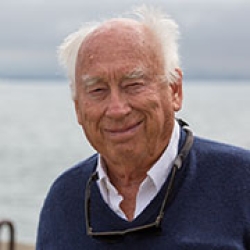
Richard Dugdale
Biography
I am a world-renowned biological oceanographer specializing in marine biogeochemistry and modeling. My lab studies the interaction of phytoplankton, nutrients (primarily nitrogen and silicon), and carbon dioxide. I have been recognized with the Hutchinson Award from the Association for the Sciences of Limnology and Oceanography, Fellow of the American Geophysical Union, Fellow of American Association for the Advancement of Science, Fellow of California Academy if Sciences and an Honoris Causa from the University of Marseilles. My extensive bibliography (170 peer reviewed papers with 2 citation classics) covers research in estuaries including San Francisco Bay, coastal upwelling areas worldwide and the equatorial Pacific
For context, I pioneered the use of the stable isotope 15N as a tracer in aquatic studies that enabled primary production by phytoplankton to be separated into production based on the input of "new" nutrients or on regenerated nutrients, and the concept of new production, now a basic paradigm of biological oceanography that allows the estimate of primary production available for export up the food chain or downward to the deep sea and sediments. My current research is focused on the causes of low productivity and algal blooms in the San Francisco Estuary/Delta ecosystem and links to anthropogenic inputs of ammonium. We contribute to the development of the Bay coupled circulation and biogeochemical model, SCHISM/CoSiNE. Another interest is on the role of the California Undercurrent in linking and providing nutrients to upwelling centers along the West Coast and implications of climate change.
Selected Papers
- Dugdale, R.C, A.E. Parker, F.P. Wilkerson. 2024. Patterns in anthropogenic nitrogen and water quality leading to phytoplankton blooms in urban estuaries. Journal of Marine Science & Engineering. 12 (11). doi.org/10.3390/jmse12112029
- Glibert, P. M., F. P. Wilkerson, R. C. Dugdale, and A. E. Parker. 2022. Ecosystem recovery in progress? Initial nutrient and phytoplankton response to nitrogen reduction from sewage treatment upgrade in the San Francisco Bay Delta. Nitrogen 3, no. 4: 569-591.
- Wang, Z., F Chai, H. Xue, X. H. Wang, Y.J. Zhang, R. Dugdale, F. P. Wilkerson. 2021. Light regulation of phytoplankton growth in San Francisco Bay studied using a 3D sediment transport model. Frontiers in Marine Science 8: 758, doi=10.3389/fmars.2021.633707
- Wang, Z., F Chai, R Dugdale, Q Liu, H Xue, F Wilkerson, Y Chao, Y Zhang. 2020 The interannual variabilities of chlorophyll and nutrients in San Francisco Bay: A modeling study. Ocean Dynamics 70 (8), 1169-1186.
- Liu, Q., F. Chai, R.C. Dugdale, Y. Chao, H. Xue, S. Rao, F. Wilkerson, J. Farrara, H. Zhang, Z. Wang, and Y. Zhang. 2018. San Francisco Bay nutrients and plankton dynamics as simulated by a coupled hydrodynamic-ecosystem model. Continental Shelf Research 161: 29-48.
- Chao, Y., J.D. Farrara, E. Bjorkstedt, F. Chai, F. Chavez, D. Rudnick, W. Enright, J. L. Fisher, W.T. Peterson, G.F. Welch, C.O. Davis, R.C. Dugdale, F.P. Wilkerson, H. Zhang, Y. Zhang, E. Ateljevich. 2017. The origins of the anomalous warming in the California coastal ocean and San Francisco Bay during 2014-2016. [#2017JC013120] Journal of Geophysical Research – Oceans 122.
- Dugdale, R.C. 2018. A biogeochemical oceanographer at sea: my life with nitrogen and a nod to silica. Annual Reviews in Marine Science 10: 1-18
- Dugdale, R.C., F.P. Wilkerson, A.E. Parker. 2016. The effect of clam grazing on phytoplankton spring blooms in the low-salinity zone of San Francisco Estuary: a modelling approach. Ecological Modelling 340: 1-16.
- Wilkerson, F.P. and R.C. Dugdale. 2016. The ammonium paradox of a high nutrient low chlorophyll estuary. In: Aquatic Microbial Ecology and Biogeochemistry: A Dual Perspective” (P.M. Glibert and T.M. Kana (eds), Springer, pp. 117-126.
- Glibert, P.M., F.P. Wilkerson, R.C. Dugdale, J. A. Raven, C. Dupont, P.R. Leavitt, A.E. Parker, J.M. Burkholder, T.M. Kana. 2016. Pluses and minuses of ammonium and nitrate uptake and assimilation by phytoplankton and implications for productivity and community composition, with emphasis on nitrogen-enriched conditions. Limnology and Oceanography 61: 165-197.
- Wilkerson, F.P., R.C. Dugdale, A.E. Parker, S.B. Blaser, A. Pimenta. 2015. Nutrient uptake and primary productivity in an urban estuary: using rate measurements to evaluate phytoplankton response to different hydrological and nutrient conditions. Aquatic Ecology 49(2): 211-233.